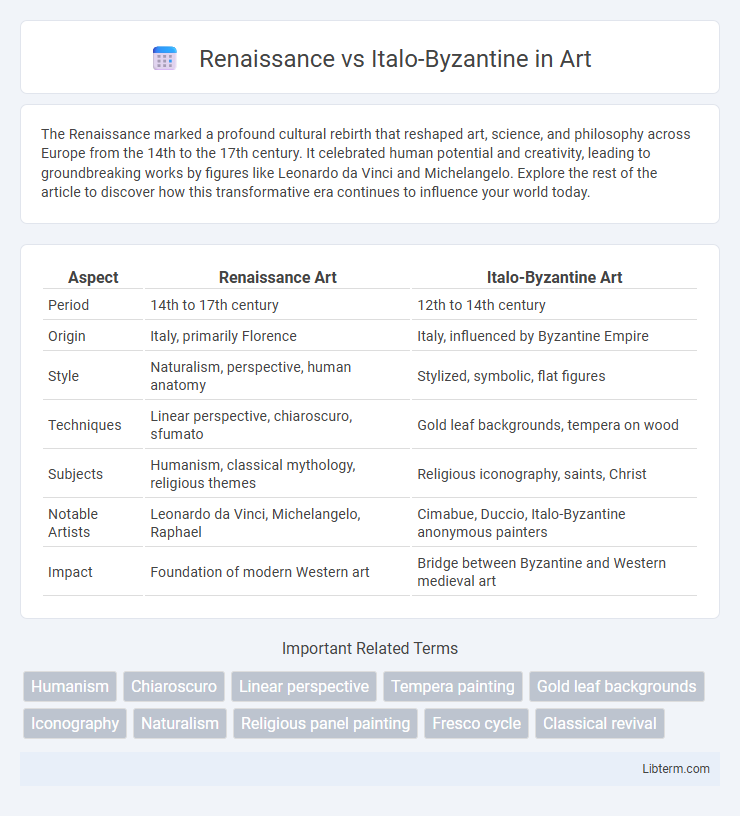The Renaissance marked a profound cultural rebirth that reshaped art, science, and philosophy across Europe from the 14th to the 17th century. It celebrated human potential and creativity, leading to groundbreaking works by figures like Leonardo da Vinci and Michelangelo. Explore the rest of the article to discover how this transformative era continues to influence your world today.
Table of Comparison
| Aspect | Renaissance Art | Italo-Byzantine Art |
|---|---|---|
| Period | 14th to 17th century | 12th to 14th century |
| Origin | Italy, primarily Florence | Italy, influenced by Byzantine Empire |
| Style | Naturalism, perspective, human anatomy | Stylized, symbolic, flat figures |
| Techniques | Linear perspective, chiaroscuro, sfumato | Gold leaf backgrounds, tempera on wood |
| Subjects | Humanism, classical mythology, religious themes | Religious iconography, saints, Christ |
| Notable Artists | Leonardo da Vinci, Michelangelo, Raphael | Cimabue, Duccio, Italo-Byzantine anonymous painters |
| Impact | Foundation of modern Western art | Bridge between Byzantine and Western medieval art |
Introduction to Renaissance and Italo-Byzantine Art
Renaissance art emerged in 14th-century Italy, emphasizing naturalism, human anatomy, perspective, and classical antiquity inspired themes. Italo-Byzantine art, dominant in the 12th-13th centuries, fused Byzantine spiritual symbolism with Italian stylistic elements, characterized by flat, frontal figures and gold backgrounds. Renaissance artists like Leonardo da Vinci and Michelangelo prioritized realism and spatial depth, contrasting with the more abstract, icon-focused approach of Italo-Byzantine painters such as Cimabue.
Historical Contexts: Origins and Influences
The Renaissance emerged in 14th-century Italy as a revival of classical Greco-Roman art, philosophy, and humanism, heavily influenced by ancient texts rediscovered during the fall of Constantinople. In contrast, the Italo-Byzantine style, dominant between the 12th and early 14th centuries, reflected the strong influence of Byzantine iconography and religious themes transmitted through trade and political connections with the Eastern Roman Empire. These distinct historical contexts shaped their artistic developments, with the Renaissance emphasizing naturalism and perspective, while Italo-Byzantine art prioritized symbolic representation and spiritual expression.
Key Artists and Their Masterpieces
Renaissance art, exemplified by artists like Leonardo da Vinci with his masterpiece "Mona Lisa" and Michelangelo's "David," emphasizes realism, human anatomy, and perspective, marking a departure from the stylized approach of Italo-Byzantine art. Italo-Byzantine art, represented by Cimabue and his "Santa Trinita Madonna," features iconic gold backgrounds and elongated figures with spiritual symbolism, reflecting Byzantine influences. The transition from Italo-Byzantine to Renaissance art showcases a shift from religious abstraction to naturalism and individual expression.
Stylistic Differences: Color, Form, and Composition
Renaissance art emphasizes naturalism with balanced compositions, lifelike forms, and a rich, yet harmonious color palette that reflects realistic lighting and perspective. Italo-Byzantine style features flat, gold backgrounds, elongated figures with stylized, rigid forms, and a symbolic use of color rather than realistic shading. The Renaissance prioritizes three-dimensionality and spatial depth, while Italo-Byzantine art focuses on spiritual representation through abstract, decorative elements.
Religious Themes and Symbolism
Renaissance art emphasizes naturalism, human emotion, and three-dimensional space, transforming religious themes with lifelike figures and realistic settings that reflect human experience and divine presence. In contrast, Italo-Byzantine art centers on symbolic representation, using gold backgrounds, frontal poses, and elongated figures to convey spiritual otherworldliness and doctrinal authority. The shift from Italo-Byzantine iconic symbolism to Renaissance humanism marks a fundamental change in visual theology, portraying sacred subjects with increased accessibility and emotional depth.
Techniques: Fresco, Tempera, and Oil Painting
The Renaissance revolutionized painting techniques by emphasizing realism and depth through oil painting, which allowed for richer colors and finer detail compared to the flat, stylized forms of Italo-Byzantine frescoes and tempera works. Italo-Byzantine art predominantly used tempera on wooden panels, characterized by its matte finish and limited shading, while frescoes involved applying pigment onto wet plaster, creating durable but less flexible imagery. The advent of oil paint in the Renaissance enabled artists like Leonardo da Vinci and Jan van Eyck to achieve unprecedented texture, luminosity, and subtle gradations of light and shadow.
Humanism in Renaissance vs Iconography in Italo-Byzantine
Renaissance art emphasizes humanism, focusing on the realistic portrayal of the human body, individual expression, and a revival of classical antiquity to celebrate human potential and intellect. In contrast, Italo-Byzantine art centers on religious iconography, characterized by stylized figures, gold backgrounds, and symbolic representations intended to convey spiritual truths rather than naturalistic detail. The divergence between Renaissance humanism and Italo-Byzantine iconography highlights a shift from spiritual symbolism to empirical observation and individualism in artistic expression.
Impact on Architecture and Decorative Arts
The Renaissance style emphasized symmetry, proportion, and the revival of classical Greco-Roman elements, profoundly influencing architecture through innovations such as domes, columns, and pilasters. In contrast, the Italo-Byzantine style was characterized by intricate mosaics, gold leaf backgrounds, and stylized figures, impacting decorative arts with its spiritual symbolism and elaborate iconography. This divergence shaped the evolution of European art, where Renaissance architecture balanced humanism and engineering while Italo-Byzantine art preserved religious tradition through ornamental richness.
Legacy and Influence on Modern Art
The Renaissance revolutionized art with its emphasis on naturalism, perspective, and anatomical accuracy, setting foundational principles for modern Western art. The Italo-Byzantine style, characterized by its iconic, religious imagery and symbolic formality, significantly influenced the development of religious iconography and early Italian art traditions. Together, these movements shaped the trajectory of art history, blending spiritual symbolism with emerging humanism that continues to inform contemporary artistic expression and techniques.
Conclusion: Lasting Significance and Comparison
The Renaissance art movement emphasized naturalism, human emotion, and perspective, contrasting with the Italo-Byzantine style's iconic, flat, and symbolic representation. Renaissance innovations in anatomy, light, and space shaped Western art's trajectory, while Italo-Byzantine art preserved spiritual and religious symbolism crucial for medieval ecclesiastical contexts. The enduring significance lies in Renaissance art's influence on modern realism and individual expression, whereas Italo-Byzantine art remains a testament to early Christian artistic traditions.
Renaissance Infographic

 libterm.com
libterm.com